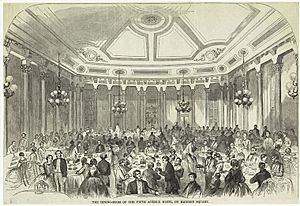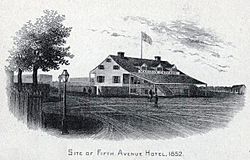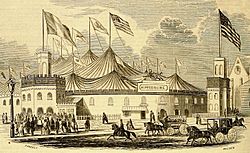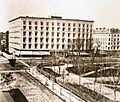Fifth Avenue Hotel facts for kids
Quick facts for kids Fifth Avenue Hotel |
|
|---|---|
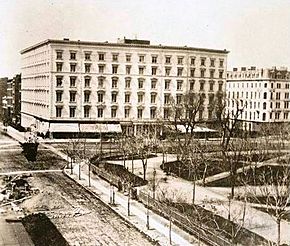
(1860)
|
|
| General information | |
| Address | 200 Fifth Avenue |
| Coordinates | 40°44′31″N 73°59′22″W / 40.74205°N 73.98945°W |
| Construction started | 1856 |
| Completed | 1859 |
| Inaugurated | 23 August 1859 |
| Demolished | 1908 |
| Owner | Amos R. Eno |
| Design and construction | |
| Architect | Griffith Thomas with William Washburn |
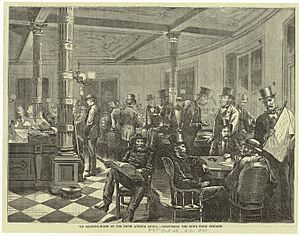
The Fifth Avenue Hotel was a very fancy hotel in New York City. It opened in 1859 and closed in 1908. You could find it at 200 Fifth Avenue in Manhattan. It took up a whole block between 23rd and 24th Streets, right near Madison Square.
Contents
Where the Hotel Stood
Before the hotel was built, the land had a different history. First, it was home to Madison Cottage. This was a stop for stagecoaches carrying people north from the city.
Later, from 1853 to 1856, a place called Franconi's Hippodrome was there. It was a huge tent-like building made of canvas and wood. It could hold up to 10,000 people! They came to watch exciting chariot races and other ancient Roman shows.
Building the Famous Hotel
The Fifth Avenue Hotel was built between 1856 and 1859. A man named Amos Richards Eno paid $2 million to build it. That was a huge amount of money back then!
The building was designed by Griffith Thomas and William Washburn. At first, some people called it "Eno's Folly." This was because it was built far from the main part of the city. They thought it was a silly idea.
But they were wrong! After it opened, the hotel became a very popular place. It was a center for important social, cultural, and political events in New York. It even made a quarter of a million dollars in profit each year. The hotel's success also helped other hotels and buildings get built nearby.
Inside the Grand Hotel
The Fifth Avenue Hotel was made of brick and white marble. It had five floors above a ground floor with shops. It was one of the first hotels in the United States to have a passenger elevator. This elevator was called a "vertical screw railway." It was powered by a steam engine and carried guests to the upper floors.
The outside of the hotel looked simple, but the inside was very fancy. The public rooms had lots of gold, rich red or green curtains, and beautiful furniture. One writer said it looked "handsome and comfortable." A reporter from London even said it was "larger and more handsome" than Buckingham Palace!
The hotel had 400 workers to help its guests. It also offered private bathrooms, which was very rare and special at that time. Every room even had its own fireplace. Many people thought the hotel's success showed that New Yorkers wanted more luxury and comfort in their lives.
Famous Guests and Important Meetings
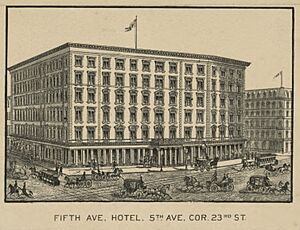
The Fifth Avenue Hotel welcomed many famous people from both America and other countries. For a while, it was the most exclusive hotel in the city. It was also the main place for social events for New York's wealthy people.
Many important figures stayed or met here. Ulysses S. Grant started his campaign for president at a dinner party in the hotel. He and his cabinet even held an official meeting there once. Chester A. Arthur, who later became president, had an office suite in the hotel.
Important visitors from other countries also stayed here. These included Edward, Prince of Wales (who later became King of England), the Duke of Argyll, Dom Pedro of Brazil, and Prince Agustín de Iturbide y Green of Mexico.
The hotel was also a meeting spot for powerful business leaders like Jay Gould and Cornelius Vanderbilt. They would even trade stocks there after the stock market closed.
The hotel was the setting for a famous political meeting in 1876. The editor of The New York Times woke up a political leader in a hotel suite. They then planned the campaign for the very close presidential election of 1876.
The Fifth Avenue Hotel was also important for sports history. On October 20, 1873, representatives from Yale, Columbia, Princeton, and Rutgers met there. They created the first official rules for college football. Before this meeting, each school had its own rules.
Later, on May 21, 1881, the United States Tennis Association was founded at the Fifth Avenue Hotel.
The "Amen Corner"
The Fifth Avenue Hotel was a strong base for the Republican Party. A powerful political leader named Thomas Collier Platt had a special spot in one of the public rooms. He called it his "Amen Corner." From here, he controlled many political decisions in New York in the 1890s. He would hold his "Sunday School" meetings there. Nothing would happen until he gave his "amen," meaning his approval.
The Hotel's End
The Fifth Avenue Hotel closed its doors at midnight on April 4, 1908. It was then torn down. People said that on its last day, guests at the hotel's bar spent $7,000 on drinks!
In 1909, a new office building was built on the site. It was called the Fifth Avenue Building. This building later became known as the Toy Center. It was a place where toy companies showed their products to buyers.
Today, a special plaque on the Toy Center remembers the famous Fifth Avenue Hotel.
Images for kids
-
Illustration of the Fifth Avenue Hotel reading room, Every Saturday (1871)
-
The Fifth Avenue Hotel, depicted on the Taylor Map of New York (1879)
See also
 In Spanish: Fifth Avenue Hotel para niños
In Spanish: Fifth Avenue Hotel para niños


